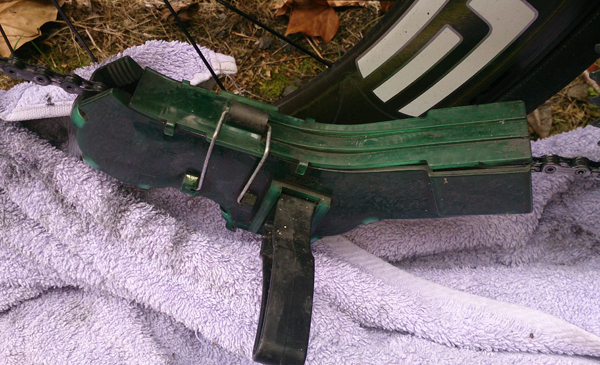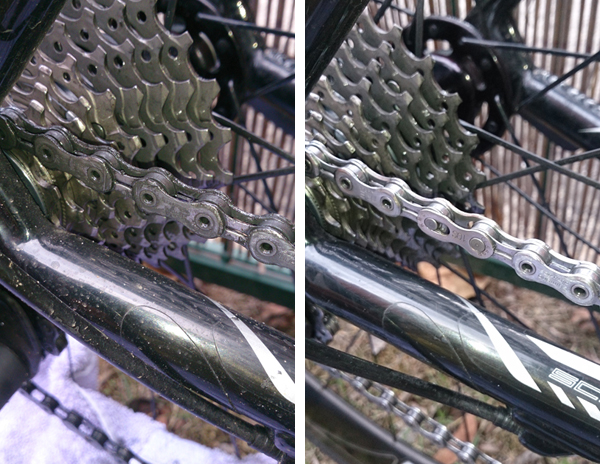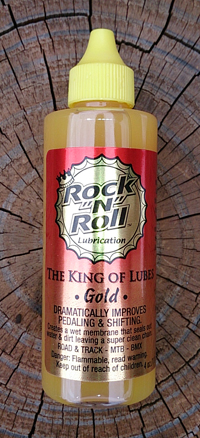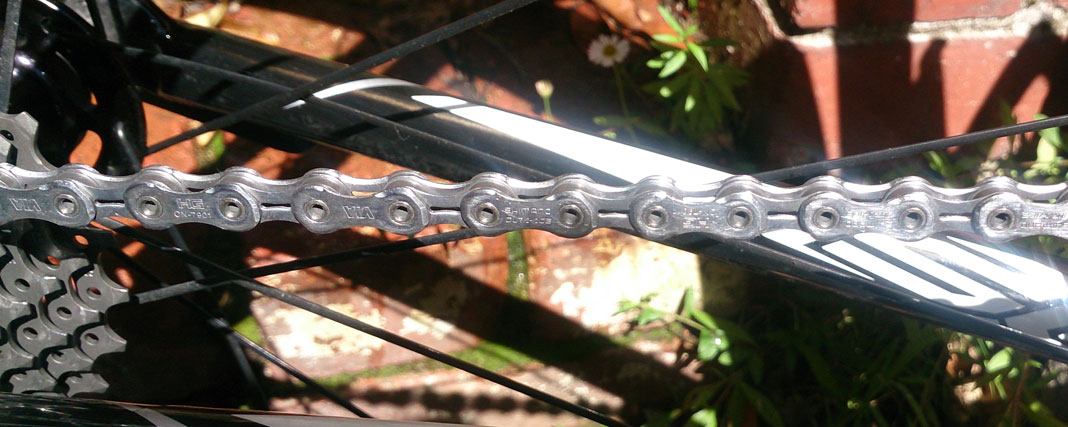Cleaning your chain is the number one cleaning task for your bike. While everything on your bike can be covered in mud and that black road grime, your drivetrain should be spotless!
You will extend the life of your sprockets and chain, shifting will be improved and your bike will look much better. How should it be done?
You will extend the life of your sprockets and chain, shifting will be improved and your bike will look much better. How should it be done?
Why keep your drivetrain spotlessly clean?
The drivetrain consists of your chain, front chainrings, rear sprockets and derailleur pulleys. These are the reasons to keep them clean:
Improve efficiency
A clean chain will consume about 7-10W at 250W (that's the power to ride at roughly 22mph/35kph on a flat road). A dirty chain will consume about 6-10W more, which is a significant loss of power.
Sprint power might be 1000W so you may not feel that 6W is anything to worry about, but the power loss is proportionally greater at higher power - enough to make you lose by half a wheel.
Reduce wear
The grit from the road, mixed with lubricant will form a grinding paste. The pins (or rivets) of the chain will wear grooves where the chain plates rub, which will cause the chain to lengthen. This is referred to as chain stretch, and can be measured most reliably with a ruler, although you can also use a chain measuring tool.
A new chain, under tension, should measure 10 pins as 10 inches (25.4cm). If the length is more than 1/16 inch / 1.5mm over this, then change the chain. The sprockets will probably be OK. You can usually replace 3 chains for each sprocket replacement. The chainrings can usually support 5-6 chain replacements before they need to be replaced.
If it is over 1/8 inch / 3mm, then the most frequently used sprockets will probably be too worn. A new chain will not sit properly on these sprockets and will skip, especially under higher power. The whole block will need to be replaced, as manufacturers make it difficult to purchase single sprockets. It would be a lot cheaper if they did!
Reduced wear will result in a longer operating life of your drivechain. Since chains, sprockets and chainrings are expensive, it will save you hundreds of dollars each year.
Improve shifting performance
A clean chain is important for crisp shifting performance, especially with 10 and 11 speed systems. I often find that poor shifting can be rectified with a clean. Even 2 weeks' worth of grime can cause a noticeable deterioration in shifting performance.
Looks great!
Your bike will look terrible with an oily, grimy chain. A nice clean chain and block looks great.
How to clean your chain
Your chain should be cleaned and lubricated after every wet ride. Even an hour in the rain will load your chain with grit and this will start wearing your cogs and chain rapidly. If you have only ridden in the dry, then clean it every 2-3 weeks or 600 miles/ 1000km.
The best method is to use one of the chain cleaning tools. These are miraculous in their ability to clean a chain whist minimizing hassle and mess.

Finish Line Chain Cleaning Tool. This one is about 3 years old, but still working well.
If the chain is very dirty, first rinse the chain with water to remove grit. If you live in an apartment you might need to put the bike in the shower to get this done. Obviously don't let your wife/ gf see you doing this! Make sure you clean up spotlessly afterwards; think CSI.
Lay down some newspaper or an old towel on the ground under the chain and cover the back wheel as best you can. There will be drips and splashing of black gunk so be warned.
It is also highly recommend to put on some latex gloves, or washing up gloves prior to doing this. It is ten times easier than trying to scrub oil out of your fingers. You will see the toughest looking motocrossers daintily put on a pair of latex gloves prior to fiddling with an engine, so if it is okay for them it is okay for cyclists too!
Run the chain through the cleaning device. You can use branded solvents such as MucOff or FinishLine but these tend to be expensive. I prefer to use white spirit (mineral spirits, turpentine substitute) from a hardware store. This works well to dissolve grease, and evaporates quickly without leaving too much smell. Methylated sprits does not work as it won't dissolve the grease. Kerosene does dissolve the grease but smells strong and takes a long time to evaporate.
Run the chain through about 20-30 pedal revolutions until it looks clean. Next, run the chain through a towel to remove excess solvent. At this point you can give the chainrings a good wipe. Your chain should now be gleaming!

Chain before and after 60 seconds through the chain cleaning tool with solvent. It comes up sparkling. Wipe off the excess solvent with a towel and let the chain dry before applying lubrication.
You might also want to use a brush dipped in solvent to give the front derailleur and sprockets a clean too. If you want to be really thorough you'll have to remove the sprockets, but that's usually overkill.
As another optional extra you might want to give the chain another once over with a soapy sponge, especially if you are cleaning the rest of your bike.
If you twist the chain you can hear if there is still grit in there. By now, all traces of grit should be gone. Let the bike dry, then it is time to lubricate your chain.
Other methods of chain cleaning are
- Use an old toothbrush and solvent. This is very messy as the brush will flick blackened solvent everywhere, including your face. It doesn't clean the chain very well.
- Remove the chain and soak it in a bottle/ pan of solvent. This works well, but you will use more solvent this way, and removing the chain can be a hassle. If you've attached the chain with the Shimano pin, then it is best to leave the chain on the bike. If you've used a removable quick link then it makes the job easier.
- If you want to be very thorough, then you can remove the chain and put it in an ultrasonic cleaning bath
Lubrication
The type of lubrication will affect friction loss, although only by a few Watts. The difference between the best and worst lube will cost you about 3-4W at 18mph/ 30kph, so it is negligible, but worthwhile as part of a 'marginal gains' philosophy.

Rock n Roll Gold lube. This came out as top commercial lubricant in Friction Facts' lube test. Only paraffin treatment beat it. You can feel the difference when you spin the cranks backwards.
The best lube is paraffin wax. The application requires a cooker as well as chain removal. Flammable paraffin wax pellets need to be melted gently in an electric cooker to about 150F/ 65C. The chain needs to be removed and dipped in the wax. You can then re-install the chain and ride. You will get about 600mi/ 1000km between applications. This provides the best lubrication in wet and dry conditions.
The paraffin wax method can be a hassle, so commercial drip on lubricants with Teflon are the best practical solution. In tests performed by Friction Facts, Rock-n-Roll Gold Chain Lube came out best, followed by Rock-n-Roll Absolute Dry, TriFlow Soy Lube and Finish Line Dry Teflon. (Note 1: The free report has been removed from the Friction Facts website, Jan 2014. Note 2: the paraffin wax was slightly better than the RnR Gold.)
WD40 and GT85 score badly and will add about 2W to chain friction, so are best avoided.
Don't over-apply the lubrication. Apply a drop to the hinge of each link. Yes, it'll have to be done over 100 times but it only take about a minute. Once you have spun the cranks to work the lube in, wipe off the excess with a rag.
If you have left your bike to dry overnight, it is easy to forget to lube your chain before the next ride. You will only notice the mistake when you are 5km from home and your chain starts to squeak. I recommend leaving the bottle of lube next to your bike so you will remember.
It is also worth noting that the lubrication on new chains supplied by the manufacturer is worse than bottled Teflon lube (by 1-2W). It won't matter on a training bike, but on a race bike you are advised to remove the packing lube and replace it with proper lube.
Conclusion
It you don't clean anything else on your bike, at least keep your drive train clean. With a chain cleaning device the job is quick and simple and the result is well worth it, saving you money and improving performance.
Links
Rock n Roll Lube Gold website. This teflon-based lubricant came out best in tests.
Friction Facts Great website but seems like the author had to stop updates as he wasn't able to make it commercially viable.
